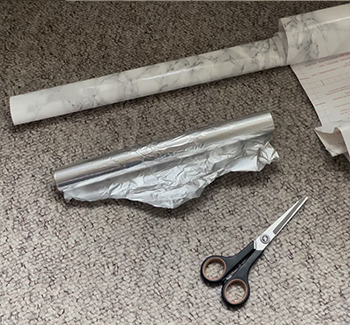A woman has shared a clever hack for saving money on heating this winter – and it involves a cheap household staple.
Claire Douglas, 40, from Tunbridge Wells, came up with a simple way of maximising heat in her house to help cut costs throughout the colder months by making a DIY homemade radiator reflector – though she warns it won’t look pretty.
READ MORE: Woman, 27, shares summer hack to rid clothes from sweat patch stains – using PANTY LINERS
The home interiors buff, who shared the tip with her 28,000 followers on Instagram (@clairedouglasstyling ), revealed how strategically placing tin foil behind her radiator helps maximise the heat being blasted in the room, and reduce heat loss.
To create the reflector, she sticks the tin foil onto a strip of self-adhesive vinyl, and then uses it to line the area behind radiators.
She says the simple trick can help save on the heating bill, and offers tips on how to enhance results.
“I was so impressed with the effectiveness of this hack,” Claire told What’s The Jam.
“There was a noticeable difference once the foil-covered vinyl sheets were in place behind our radiators.
“I noticed the biggest improvement in our bedroom, which was very cold prior to installing the foil.
“I was especially happy as the hack didn’t cost anything because we had the foil and roll of DC Fix already.”
Claire decided to try it out after finding her bedroom chilly through the winter months.
She said: “I looked into how I could make them warmer without cranking the heating up a notch because, let’s face it, energy prices are already ridiculous as they are.
“I know you can buy specialist radiator foil panels, but they aren’t cheap, and regular readers will know that I much prefer employing creative and money-saving techniques wherever possible.
“Placing foil behind radiators can reduce heat loss, making the radiator more effective and saving you money.
“After researching on the internet and applying the findings to our particular house and energy bills, I calculated that this hack saves 2-5% on annual bills – which for us would represent a £50-125 per year saving.”
However, she warns that the final result doesn’t necessarily lead to a chic look in the home – saying “It’s not pretty, but it works”.
Claire says there are a few ways to do it – the first of which is to simply place a piece of tin foil on its own behind the radiator.
However, this can lead to scrunching and wrinkling, and optimal results will come from shiny, uncreased foil.
Claire said: “Because the aim of the game is to reflect the heat back into your living space to ensure less energy wastage, we need the foil to be shiny so any creases and folds will reduce the effectiveness.
“To overcome these issues, you could wrap the foil around a piece or card, as this will help keep the foil flat and smooth, making it a better DIY radiator reflector.
“While that approach should work, I had a better idea involving some DC Fix vinyl wrap that I had in the cupboard.
“You likely have seen this in DIY and craft stores – it’s basically stick-backed plastic with a design of some kind on the outer side; in this case, it’s a faux marble effect.”
Claire added: “If you live in a well-insulated property with little energy loss and low household bills, this might not make much difference or be the game-changing hack for you.
“But, if, like millions of us in the UK at the moment with older homes, high energy costs, external solid walls and many an exterior wall radiator, then this nifty hack might just make your day – as it did mine.”
She also warned that the material of the walls can have an impact, with the trick working best on radiators located on solid outside walls.
Sharing the step-by-step process, Claire starts by measuring the dimensions of the radiator, noting where the radiator brackets are positioned as gaps will need to be cut out in the foil panel to help it slide easily behind the radiator.
Next, she marks the dimensions on the vinyl sheet, including the wall brackets, and cuts the panel to fit.
She then applies the foil, peeling back sections of the sticky backing, and smoothing the foil over it to ensure no air bubbles.
Once covered, she cuts the foil along the channels for the wall brackets, and folds the foil back behind the panel – creating a smooth, flat edge.
Finally, she positions the reflective panel behind the radiator to ensure it doesn’t crease or wrinkle, lines up the channels cut out for the wall brackets, and slots it into place.
Claire said: “I can personally attest to the aluminium foil behind the radiator hack being very effective for certain wall types.
“In our house, the bedroom radiators are located on external walls that have been cold this winter and adding the foil-backed vinyl wrap made a big difference to the power of the radiators to heat the room.”
Encouraging people to try it out, she added: “Getting your radiators working to maximum effect after only a few simple steps with some standard kitchen foil and no upfront cost surely has to be worth a go, right?”
READ MORE: ‘I rummage through skips and gift other people’s trash as presents to family’
